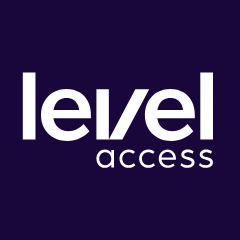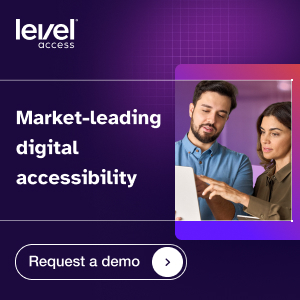WCAG 2.2 AA: Summary and Checklist for Website Owners
Aug 21, 2024
The most recent version of the Web Content Accessibility Guidelines (WCAG), version 2.2, was released in October of 2023. With WCAG remaining the global standard for understanding and evaluating digital accessibility, you may be wondering how WCAG 2.2 compares to previous versions—and when your organization should start conforming with these updated guidelines.
In this blog, we’ll briefly explain the differences between WCAG 2.2 and WCAG 2.1 and discuss the benefits of WCAG 2.2 conformance, including its role in regulatory compliance. We’ll also provide a checklist for website owners to work toward meeting the nine new WCAG 2.2 success criteria.
WCAG 2.1 vs. WCAG 2.2: What’s New?
WCAG 2.2 introduces nine new success criteria. These focus on accessibility for web users with low vision, cognitive and learning disabilities, and motor disabilities, including access on touch-screen devices.
How WCAG 2.2 relates to prior WCAG versions
As with WCAG 1.0, 2.0, and 2.1, WCAG 2.2 builds on previous versions. So, while WCAG 2.1 contains 78 success criteria, WCAG 2.2 contains 86 – 77 from 2.1 (removing the one that is now considered obsolete) plus nine new o`nes.
Also, like previous versions, WCAG 2.2 breaks down testable success criteria into three levels: A, AA, and AAA, with A representing the minimum conformance level and AAA representing the maximum. Meeting a conformance level is also backwards compatible, so achieving Level AA means that experience also conforms with A.
So which level should you strive to achieve? Most global accessibility regulations, such as Section 508 of the Rehabilitation Act of 1973 in the U.S., EN 301 549 in Europe, and the Accessibility for Ontarians with Disabilities Act in Ontario, Canada, require Level AA conformance. While you might strive to achieve the highest level, AAA, these more advanced accessibility measures are not required by current laws, nor are all success criteria in the AAA level applicable for every digital experience.
The vast majority of website owners should focus on Level AA—the globally accepted and recommended tier of accessibility.
Why conform with WCAG 2.2?
While conformance with WCAG 2.2 may not be required by laws governing your organization, best practice is to strive to achieve WCAG 2.2 AA conformance. By satisfying the nine new success criteria, your organization will better serve users with a broader range of disabilities, ultimately enhancing your audience’s experience. Additionally, maintaining conformance with the most recent version of WCAG demonstrates that your organization remains up to date on digital accessibility best practices, underscoring your commitment to inclusion.
WCAG 2.2 conformance is also a best practice for long-term compliance with U.S. and international laws. These updates guidelines are already being incorporated into regulations: for example, EN 301 549, which is the presumptive standard for European Accessibility Act (EAA) compliance, is expected to adopt WCAG 2.2 in 2025. Meanwhile, the digital accessibility requirements for U.K. public-sector organizations are anticipated to incorporate WCAG 2.2 as early as October of 2024. Several U.S. states, including Colorado, have similarly expressed their intent to update the compliance standard for state laws from WCAG 2.1 to 2.2.
Even if your organization is not yet legally obligated to conform with WCAG 2.2, meeting the new success criteria sooner rather than later will ensure you stay ahead of changing regulations.
WCAG 2.2 Checklist
Now that you understand the benefits of WCAG 2.2 conformance, you may be wondering what meeting the updated guidelines involves in practice. It’s worth noting that most of the new criteria are best addressed during design, rather than later in development or testing. The checklist below can help you get a better understanding of the WCAG 2.2 success criteria and how they can advance the accessibility of your website, app, or other digital experience.
- 2.4.11 Focus Not Obscured – Minimum (Level AA): When a user interface component receives keyboard focus, at least a portion of it must remain visible and not be hidden by other content you provide.
- 2.4.12 Focus Not Obscured – Enhanced (Level AAA): When a user interface component receives keyboard focus, none of the focus indicator may be hidden by your content. This is the AAA level of success criterion 2.4.11 listed previously.
- 2.4.13 Focus Appearance (Level AAA): Focus indicators must have sufficient color contrast between the focused and unfocused states and must be of a sufficient size so as to be clearly visible.
- 2.5.7 Dragging Movements (Level AA): If any part of your website requires a dragging movement, provide an alternative means of dragging, such as tapping or clicking. For example, instead of dragging a map, the interface could offer buttons that move the map in a particular direction.
- 2.5.8 Target Size – Minimum (Level AA): All interactive targets should be at least 24×24 CSS pixels in size. This can include padding within the target. Additionally, there must be sufficient space between targets.
- 3.2.6 Consistent Help (Level A): If you make a help option available, make sure it’s available consistently, and in the same relative place. This will make it easier to locate while navigating your website.
- 3.3.7 Redundant Entry (Level A): In a process, such as registering or completing a form, information that the user has already entered must be made available to them. This helps users by not making them enter information more than once unless it’s absolutely necessary.
- 3.3.8 Accessible Authentication- Minimum (Level AA):. If your site requires a cognitive test, such as memorizing a username and password in order to log in, there needs to be a different way to authenticate that doesn’t require the ability to do that, or a help mechanism needs to be made available to assist with that. For example, a username and password field that allows for entry by a password manager assists, as would allowing for the user to paste into the fields. At this level, a cognitive function test that requires the recognition of an object, like a stop sign, is allowed, as is a test that asks a user to identify a picture or image the user provided to the website.
- 3.3.9 Accessible Authentication – Enhanced (Level AAA): Users shouldn’t be forced to memorize information or necessarily spell correctly. Those and other tasks are considered cognitive tests. If an authentication process has a cognitive function test in a step, the site needs to provide an alternative that doesn’t or provide a help mechanism to complete the test. In addition—and this is a key difference between SC 3.3.8 and 3.3.9—authentication by using object recognition or user-provided content (e.g., a picture uploaded by the user) isn’t permitted at this level.
Note: WCAG conformance is not the same as legal compliance. However, in the current legal landscape, WCAG conformance is a recommended best practice for avoiding a web accessibility lawsuit. WCAG is globally accepted as the benchmark for meeting the effective communication requirements of the Americans with Disabilities Act (ADA) and complying with other U.S. and international laws.
Accessibility is a long game. Stay the course with Level Access.
Achieving digital accessibility is an ongoing, dynamic process. Laws change in response to user needs, and WCAG success criteria evolve as technology evolves, requiring website owners to stay on top of their content. There’s no such thing as a one-and-done solution for web content accessibility.
The good news is that with the right support, WCAG 2.2 AA conformance is achievable. Explore our solution to learn more about how Level Access can help get your digital offerings in shape to reach a wider audience.
Subscribe for updates



